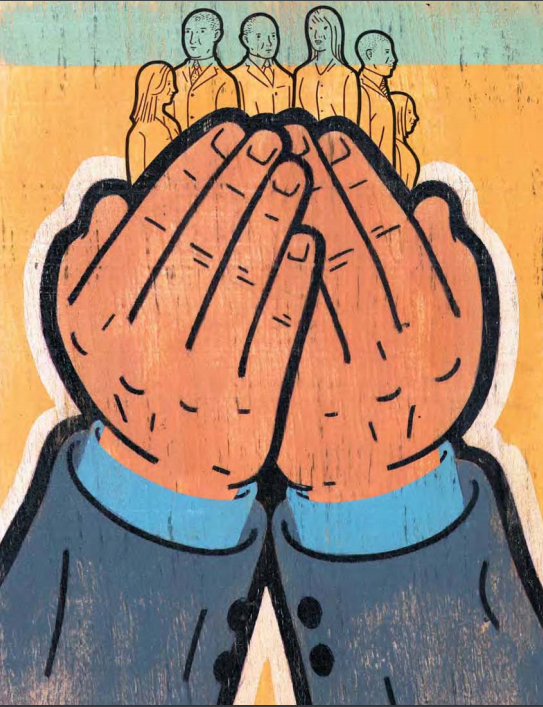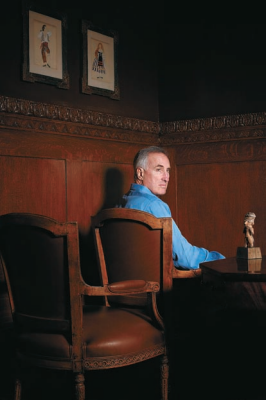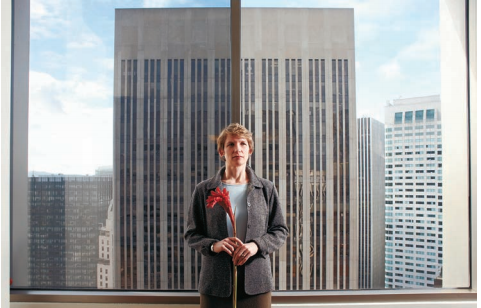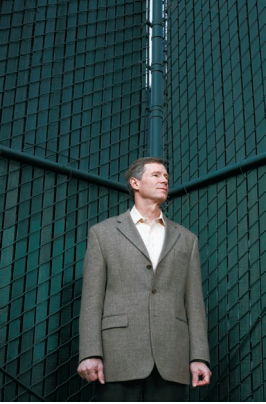Public Service: At the Core of the Profession
Reuben Jeffery III spent 18 years with Goldman, Sachs &company, including nearly a decade in London and Paris, where he specialized in international capital markets, corporate finance, and mergers and acquisitions. He left Goldman in May 2001 with the hope of take a much-needed break and spending more time with his family. But as he watched the horrors of September 11, 2001, unfold on television, he knew he had to do something. “I didn’t know how or what it meant,” recalls Jeffery JD/MBA ’80. “I just looked at what was going on, thought about where I was in life, and came to the conclusion that if there was a way I could do something more public service-oriented, I wanted to do that.”
From Europe, Jeffery wrote every contact he could think of in the U.S. government. Eventually he heard from a Stanford classmate who was working at the White House. The president needed someone to act as a liaison between the federal government and those charged with the long-term recovery and redevelopment of lower Manhattan—agencies like the Port Authority, the Lower Manhattan Development Corporation, the New York governor’s office, mayor’s office, and state legislators.
“The job was somewhat ill-defined at the time,” says Jeffery. In the end, though, he says it was a fascinating introduction to government service. Jeffery continues, “It proved to be hugely interesting and rewarding to feel like I was doing something that mattered.” Inspired by his new vocation, Jeffery went on to serve as an adviser to Ambassador Paul Bremer in Iraq, and then as special assistant to the president and senior director of international economic affairs at the National Security Council. Today he serves as chairman of the federal Commodity Futures Trading Commission (CFTC).
A substantial majority of Stanford Law School graduates start their careers in private firms or corporations. Some, like Jeffery, move into full-time public service after years in the private sector. Many others resolve to take on pro bono cases while working full time at traditional law firms. Some of these alumni are from the left side of the political spectrum; some are from the right; and some are neither. But as far as Dean Larry Kramer is concerned, they’re all worthy role models. He tells students,

“Some of you are going to do public interest law as a full-time career, and that’s great and should be celebrated. But the rest of you shouldn’t view yourselves as off the hook.”
His colleague Lawrence C. Marshall agrees.“This isn’t about liberal versus conservative, Republican versus Democrat,” says Marshall, the David and Stephanie Mills Director of Clinical Education and associate dean for public interest and clinical education. “It’s a mind-set that says that law is a profession—not only a business—and that part of the profession includes a responsibility to make professional services available to serve others.”
In recent years, Kramer and Marshall have worked to double the resources available to Stanford Law School’s clinics, fellowships, and other public interest-related programs. Now, thanks to a substantial gift from John Levin ’73 (MA ’70) and Terry Levin (BA ’74, MA ’81), they’re launching a broader initiative: a new center for public service and public interest law aimed at fostering enthusiasm for public service in all Stanford Law students, no matter what their career trajectory. Marshall explains that “from the very first day of law school we want this spirit of commitment to public service to be part of the DNA of the law school and part of what our students identify as the professional ethos of lawyering.”
Previous efforts at the law school to emphasize public service focused almost exclusively on career counseling for the minority of third-year students seeking nonprofit and government jobs. “We’ll continue to do all of the things we do for those students,” Kramer promises, “and indeed we can and should do a lot more for them.” Already the school has expanded its career counseling staff and enhanced its loan forgiveness program for graduates who go into full-time public interest careers.
At the same time, he says, “We need to engage the large percentage of our graduates who do not pursue careers in public service, to send a very clear message to our students that public service is a professional obligation, and to find ways to promote public service work by lawyers from within private sector careers.” The new John and Terry Levin Center for Public Service and Public Interest Law, he stresses, “really is committed to providing a focal point and a jumping-off point, to send this broader message about the legal profession as a whole.”
With the establishment of the Levin Center, the law school has developed strategies to weave a public service ethos into all aspects of its legal education. A top priority will be to strengthen Stanford Law School’s popular new pro bono program, which enables students to participate in community-based projects from their earliest weeks on campus. Those who volunteer 50 hours earn a mark of Pro Bono Distinction on their diplomas.
“The law school is proud to be proactively creating opportunities for pro bono service and shepherding students to those opportunities,” says Marshall. Another key program component, he explains, is the opportunity for reflection. After students have been out in the community, they attend group sessions where they discuss questions their work has generated.
Last fall, about two-thirds of first-year students signed up for the pro bono program. Among them was Vermont native Jessa Barnard ’08. Barnard has been involved in pro bono projects for two years, largely through a program she and a classmate founded, the Medical-Legal Collaborative. The collaborative helps families of young patients at Lucile Packard Children’s Hospital apply for benefits or resolve legal issues they may have. “It’s the sort of school where if the exact opportunity that you want does not exist, you can create it,” she explains. “The support and resources are certainly there.”
Another priority at the Levin Center will be course development. Last year, clinical education director Marshall helped develop a seminar in which students analyzed controversial cases from both sides of the political spectrum. Guest speakers included one lawyer who had been part of California’s recent campaign for parental notification about abortion and another who fought the initiative. Students also heard from lawyers working for and against same-sex marriage.
Another initiative slated for expansion is the law school’s National Public Service Awards program. Last October, the school honored two full-time public interest lawyers: Loyola law professor William Quigley for his work on behalf of Hurricane Katrina victims and Christa Gannon ’97 for her work on behalf of California youth. Soon, the dean plans to add one more award, to recognize an alumnus who isn’t a full-time public interest lawyer but has made substantial contributions through pro bono activities.
Such role models are important, Kramer explains, because once students get into the workforce, the temptation to dismiss their pro bono responsibilities can be great. “You go into a firm, and the pressure to bill hours is enormous and getting clients matters, so it’s not surprising that the job can be all encompassing,” he says. Unless students already have developed a strong respect and taste for public service, he says, “there are going to be a lot of reasons not to do it.”
Vaughn Williams ’69, a partner with Skadden, Arps, Slate, Meagher & Flom who specializes in securities class action suits, is familiar with the challenges that young associates face. When he first joined Skadden’s New York office, he spent virtually all of his time working on paid client matters as he worked his way up to partner. Gradually, though, several things happened: He learned to manage his time better, he became more secure in his relationship with the firm, and he developed a better sense of what was important to him. These days, on top of his busy litigation practice, Williams heads the boards of Lawyers for Children, Inc., and the Brooklyn Academy of Music, offering advice on governance and appropriate auditing procedures. He’s also a member of the committee that administers the Skadden, Arps Fellowship Program, which supports young lawyers who take on full-time public interest jobs.
Williams insists that the best law firms really want their associates to do pro bono work, not only for the benefits to the
THE JOHN AND TERRY LEVIN CENTER FOR PUBLIC SERVICE AND PUBLIC INTEREST LAW
For John Levin, public service is not an option—it’s a professional obligation. • “I think the whole notion of law as a profession is bundled up with the fact that it’s about service to others. That’s true of all aspects of law—both public and private,” says Levin ’73 (MA ’70), founder and senior counsel at Folger Levin & Kahn LLP and its former chairman and managing partner from 1978 to 2006. “It is essential for students to have early and frequent exposure to the meaning of public service as they develop their identities as lawyers.”
That’s why he and his wife, Terry (BA ’74, MA ’81), have contributed $3.75 million to establish the John and Terry Levin Center for Public Service and Public Interest Law. The Levin Center’s mission: to make public service part of every student’s experience, no matter his or her career path.
To provide this exposure, plans for the Levin Center include expansion of existing programs at the law school including the Pro Bono Program, a national mentorship network, Public Service Leadership Fellows, and the newly established National Public Service Awards. Also in the works: new resources for students seeking nontraditional legal careers; a lecture series; and an annual conference with the goal of encouraging discussion at the national level about public service practice for all lawyers—whether as a career or pro bono part of their practice.
The center will also fund new curriculum options. One such course launched last year examines case studies on issues ranging from abortion to gay marriage from opposing perspectives. Plans also call for seminars focusing on client relationships, impact litigation, and ethics and professional responsibility.
While the center’s goal is to cultivate students’ interest in their role as public servants, it doesn’t mean they ultimately have to, or will, work in the public sector. “We absolutely want to encourage students who wish to pursue full-time careers working in public interest law,”

says Lawrence C. Marshall, the David and Stephanie Mills Director of Clinical Education and associate dean for public interest and clinical education. “But working in service of the public is not an all or nothing deal. We want to show students that they can incorporate service into other careers as well.”
The mission is to bring public service to the forefront of legal education and practice. “What it means to be a lawyer, part of the responsibility that goes with it, is to find a space within your career, whatever your career, to give to the larger community,” says Larry Kramer, Richard E. Lang Professor of Law and Dean.
To be sure, the Levins know firsthand about public service. John chairs his firm’s philanthropic fund, is involved in a wide range of community activities, and has served on numerous boards. He is currently vice-chair of the Board of Trustees of Stanford University and a member of the Dean’s Advisory Council for Stanford Law School. Terry has been a longtime volunteer for Stanford and currently serves on the Stanford Associates’ Board of Governors, the Stanford Challenge Leadership Council, and the Overseas Studies Council.
“A commitment to serving the greater good is an essential part of being a lawyer,” say the Levins. “We are pleased to support Stanford Law School’s efforts to make public service a central part of the school’s culture.”—AMY POFTAK (BA ‘95)
associate but for the firm’s benefit as well. Success in a high-profile case can enhance a whole firm’s reputation. “For example, if we win Voting Rights Act litigation, I think my partners here will be proud that we’ve had success in a very interesting case. There’s prestige whether it’s for a paid client or not,” says Williams.
Pro bono service also can be useful for young lawyers in developing both their skills and professional ethic. Palo Alto attorney Catherine Kirkman ’89, a partner at Wilson Sonsini Goodrich & Rosati, has been actively involved in pro bono throughout her legal career, with clients ranging from Creative Commons to various East Palo Alto nonprofits. She now mentors young associates as they build out their knowledge base in the firm’s media practice while serving pro bono clients such as the San Francisco Museum of Modern Art. “There are lots of pro bono projects out there, and they can be fit in just like all the other client work we do since they’re all considered billable hours,” she says. “We have a wonderful group of young associates and we work together on these cases as a
ALISON TUCHER: HELPING TO WIN A MAN HIS FREEDOM
Alison Tucher wasn’t a lawyer yet when she started work on the biggest pro bono case of her career. The client was Rick Walker, an auto mechanic from East Palo Alto, who had been convicted and would be sentenced to life in prison for the first-degree murder of his former fiancée.
Walker’s mother, Myrtle, an East Palo Alto councilwoman, was sure her son was innocent. And as it so happened, Myrtle Walker and Tucher’s mother were good friends. Meeting for lunch, they wondered if there was any way that the younger Tucher, then a third-year student at Stanford Law School, might be able to help.

“At that point, I had one semester each of Criminal Law and Criminal Procedure under my belt,” Tucher ’92 recalls. “I doubted that I would be able to do anything helpful.” Still, the more she looked at how Walker’s case had been handled, the more unjust it seemed. Tucher was particularly troubled by the prosecution’s star witness: an East Palo Alto drug dealer, also implicated in the crime, who initially failed a polygraph test and then fingered Walker after a plea bargain. Asking around at Stanford, Tucher found some top-notch attorneys to take the case on appeal.
Over the next seven years, while Walker served hard time in prison, Tucher graduated from Stanford, clerked for Judge William A. Norris on the Ninth Circuit Court of Appeals and Justice David H. Souter on the U.S. Supreme Court, and worked as a deputy district attorney in Santa Clara County. She was just starting at Morrison & Foerster when she heard from Walker again. The Ninth Circuit had turned down his latest appeal, and Walker was worried that evidence from his case would be destroyed.
By then, Tucher was immersed in a demanding patent litigation case. Nevertheless, with the firm’s blessing, she set out to preserve Walker’s evidence and to investigate his case from the ground up. “It was a three-way balancing act,” she says of that hectic time, which involved traveling to interview inmates throughout California. “What drove me was a sense of obligation to seek justice. A man who was completely innocent was going to spend the rest of his life in state prison—unless I could prove that an injustice had been done.”
Tucher found five new witnesses who knew what happened the night of the killing. That convinced the district attorney’s office to begin its own investigation. In 2003, 12 years after his conviction, Walker walked out of prison an exonerated man. “I know that some attorneys get stuck in their ways,” he says. “But with Alison, you could just see the fire in her. She is my hero. When I needed rescuing, she was there.” Reunited with his mother and grown son, Walker now is working at an auto repair shop in Palo Alto. A civil suit against the Santa Clara County District Attorney’s Office is pending.—THERESA JOHNSTON (BA ’83)
PRO BONO: GOOD FOR SOCIETY AND GOOD FOR BUSINESS
Imagine you are 6 years old, and you have diabetes. You’re heading to first grade. You need insulin shots and frequent checks on your blood sugar, but you’re not yet able to administer them to yourself. Your parents can’t be at school with you all day, and school nurses are in short supply. Who is going to help? • Some states, like Virginia, allow trained school employee volunteers—often teachers or aides experienced with the disease—to assist youngsters with diabetes. In California, though, the vast majority of public schools insist that parents come in during the school day to take care of the problem themselves.
“When I first heard about this, I thought there must be some miscommunication,” says Kenneth Philpot ’73 (BA ’70), a partner in the San Francisco office of Reed Smith. “How can anybody refuse to assist a child with diabetes who needs help? It turns out to be one of society’s bureaucratic nightmares.”
Philpot is a senior litigator and trial lawyer with more than 25 years of experience handling complex commercial disputes. But when he received an e-mail two years ago from Reed Smith’s pro bono committee describing the hurdles that children with diabetes face in California public schools, he immediately signed on to help.

Working with attorneys from the Disability Rights Education and Defense Fund, Philpot and his colleagues filed a civil rights complaint on behalf of four East Bay families and the American Diabetes Association. Their aim is to compel the California Department of Education and districts throughout the state to provide a sufficient number of school personnel trained to check students’ blood glucose and assist with treatments.
It’s not the first time Philpot has waded into the pro bono pool. As a Stanford law student, he worked as a research assistant for Stanford Professor Tony Amsterdam, a leader in coordinating national opposition to the death penalty. He continued to do pro bono work for the NAACP Legal Defense and Education Fund after graduation.
Philpot and his partners at Reed Smith encourage their associates to follow suit. Regular e-mails from the firm’s pro bono committees offer an array of opportunities, and time spent on pro bono cases is counted toward billable hour goals. “On a selfish level, pro bono work enhances our reputation and ability to attract top lawyers,” Philpot explains, sitting in his high-rise office at the Embarcadero Center. “I want to recruit people to the firm who have a broad range of interests. To me, pro bono activities demonstrate a commitment to something more than just making money.”
In all, some 30 lawyers at Reed Smith have spent thousands of hours working with Philpot on the diabetes case, researching state and federal laws, examining school district policies and individual claims, and engaging in complex negotiations with each of three defendants. “Throughout the case, Ken has demonstrated his extraordinary skills in developing and implementing strategy and pursuing negotiations at the highest level,” says a grateful Shereen Arent (BA ’80), national director of legal advocacy for the American Diabetes Association. His commitment and that of his team “are truly making a difference,” she notes. At press time, the parties were close to reaching a settlement.—THERESA JOHNSTON (BA ’83)
team. It’s really gratifying for all of us to know that we can contribute to the community as part of private practice.”
Reuben Jeffery, who traded life at Goldman Sachs for an office in Washington’s Old Executive Office Building, has found the same rewards in government service. “I know this sounds Pollyannaish,” he says, “but whatever small contribution I’ve been able to make is dwarfed by the psychic income of the opportunity to work with highly motivated and competent people on interesting and significant issues.” No matter where Stanford law graduates are headed—to nonprofit agencies or government offices, private law firms or corporations—his advice about public service is the same: “Don’t get too hung up on whether you have the right qualifications, or whether the job is the right thing for you given where you see yourself in life,” he says. “Just have the confidence to know that there are lots of areas where a Stanfordtrained lawyer can make a difference. Things change. You can’t predict the future. But if you get involved in community activities, one thing can lead to another.”
